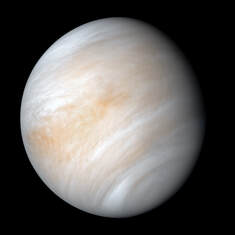VENUS
(IPISO-WAAHSA)
|
Venus is the hottest planet in the Solar System. It is covered with thick yellow clouds of sulfuric acid that hide hundreds of volcanoes and lava plains. At ground level the atmosphere is very thick- walking through it would feel almost like walking through water! Venus rotates backward compared to the other planets, which means the Sun rises in the west and sets in the east. It has two land masses that resemble continents, named Ishtar and Aphrodite. Most features on Venus are named after women.
|

